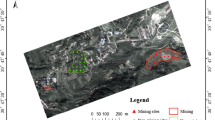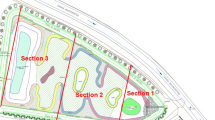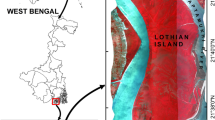Abstract
Recent advancements in hyperspectral remote sensing technology now provide improved diagnostic capabilities to assess vegetation health conditions. This paper uses a set of 13 vegetation health indices related to chlorophyll, xanthophyll, blue/green/red ratio and structure from airborne hyperspectral reflectance data collected around a derelict mining area in Yerranderie, New South Wales, Australia. The studied area has ten historic mine shafts with a legacy of heavy metals and acidic contamination in a pristine ecosystem now recognised as Great Blue Mountain World Heritage Area. The forest is predominantly comprised of different species of Eucalyptus trees. In addition to the airborne survey, ground-based spectra of the tree leaves were collected along the two accessible heavy metal contaminated pathways. The stream networks in the area were classified and the geospatial patterns of vegetation health were analysed along the Tonalli River, a major water tributary flowing through the National Park. Despite the inflow of contaminated water from the near-mine streams, the measured vegetation health indices along Tonalli River were found to remain unchanged. The responses of the vegetation health indices between the near-mine and away-mine streams were found similar. Based on the along-stream and inter-stream analysis of the spectral indices of vegetation health, no significant impact of the heavy metal pollution could be noticed. The results indicate the possibility of the vegetation having developed immunity towards the high levels of heavy metal pollution over a century of exposure.






Similar content being viewed by others
References
Archer, M., & Caldwell, R. (2004). Response of six Australian plant species to heavy metal contamination at an abandoned mine site. Water, Air, and Soil Pollution, 157(1–4), 257–267.
Assche, F. V., & Clijsters, H. (1990). Effects of metals on enzyme activity in plants. Plant, Cell & Environment, 13(3), 195–206.
Barry, K. M., Stone, C., & Mohammed, C. L. (2008). Crown-scale evaluation of spectral indices for defoliated and discoloured eucalypts. International Journal of Remote Sensing, 29(1), 47–69. https://doi.org/10.1080/01431160701281056.
Broge, N. H., & Leblanc, E. (2001). Comparing prediction power and stability of broadband and hyperspectral vegetation indices for estimation of green leaf area index and canopy chlorophyll density. Remote Sensing of Environment, 76(2), 156–172.
Clevers, J. G. P. W., Kooistra, L., & Salas, E. A. L. (2004). Study of heavy metal contamination in river floodplains using the red-edge position in spectroscopic data. International Journal of Remote Sensing, 25(19), 3883–3895. https://doi.org/10.1080/01431160310001654473.
ENVI-Mosaicking. (2013). ENVI classic tutorial: mosaicking. Boulder: Exelis Visual Information Solutions Inc..
FLAASH. (2009). Atmospheric correction module: QUAC and Flaash user guide v. 4.7. Boulder: ITT Visual Information Solutions Inc..
FLAASH. (2016). FLAASH background. Harris Geospatial Solutions. http://www.harrisgeospatial.com/docs/BackgroundFLAASH.html. Accessed 18/10/2016 2016.
Gamon, J. A., Peñuelas, J., & Field, C. B. (1992). A narrow-waveband spectral index that tracks diurnal changes in photosynthetic efficiency. Remote Sensing of Environment, 41(1), 35–44. https://doi.org/10.1016/0034-4257(92)90059-S.
Haboudane, D., Miller, J. R., Tremblay, N., Zarco-Tejada, P. J., & Dextraze, L. (2002). Integrated narrow-band vegetation indices for prediction of crop chlorophyll content for application to precision agriculture. Remote Sensing of Environment, 81(2), 416–426.
Haboudane, D., Miller, J. R., Pattey, E., Zarco-Tejada, P. J., & Strachan, I. B. (2004). Hyperspectral vegetation indices and novel algorithms for predicting green LAI of crop canopies: modeling and validation in the context of precision agriculture. Remote Sensing of Environment, 90(3), 337–352. https://doi.org/10.1016/j.rse.2003.12.013.
Harrison, J., Heijnis, H., & Caprarelli, G. (2003). Historical pollution variability from abandoned mine sites, Greater Blue Mountains World Heritage Area, New South Wales, Australia. Environmental Geology, 43(6), 680–687. https://doi.org/10.1007/s00254-002-0687-8.
Hernández-Clemente, R., Navarro-Cerrillo, R. M., Suárez, L., Morales, F., & Zarco-Tejada, P. J. (2011). Assessing structural effects on PRI for stress detection in conifer forests. Remote Sensing of Environment, 115(9), 2360–2375. https://doi.org/10.1016/j.rse.2011.04.036.
Kostarelos, K., Gavriel, I., Stylianou, M., Zissimos, A. M., Morisseau, E., & Dermatas, D. (2015). Legacy soil contamination at abandoned mine sites: making a case for guidance on soil protection. Bulletin of Environmental Contamination and Toxicology, 94(3), 269–274. https://doi.org/10.1007/s00128-015-1461-4.
Li, X., Liu, X., Liu, M., Wang, C., & Xia, X. (2015). A hyperspectral index sensitive to subtle changes in the canopy chlorophyll content under arsenic stress. International Journal of Applied Earth Observation and Geoinformation, 36, 41–53. https://doi.org/10.1016/j.jag.2014.10.017.
LPI. (2015). Land and property information: topographic map of Wollondilly. http://www.lpi.nsw.gov.au. Accessed 25/01/2015 2015.
Mukhopadhyay, S., & Maiti, S. K. (2011). Trace metal accumulation and natural mycorrhizal colonisation in an afforested coalmine overburden dump: a case study from India. International Journal of Mining, Reclamation and Environment, 25(2), 187–207. https://doi.org/10.1080/17480930.2010.548663.
Nagajyoti, P. C., Lee, K. D., & Sreekanth, T. V. M. (2010). Heavy metals, occurrence and toxicity for plants: a review. Environmental Chemistry Letters, 8(3), 199–216. https://doi.org/10.1007/s10311-010-0297-8.
NSWNP. (2015). New South Wales National Park: Historic Yerranderie Township. http://www.yerranderie.com. Accessed 25/01/2015 2015.
Ren, H., Zhuang, D., Pan, J., Shi, X., & Wang, H. (2008). Hyper-spectral remote sensing to monitor vegetation stress. Journal of Soils and Sediments, 8(5), 323. https://doi.org/10.1007/s11368-008-0030-4.
Reusen, I., Bertels, L., Debacker, S., Debruyn, W., Scheunders, P., & Sterckx, S. (2003). Detection of stressed vegetation for mapping heavy metal polluted soil. In 3rd EARSeL Workshop on Imaging Spectroscopy, 2003 (pp. 13-16).
Richards, J. A., & Richards, J. (1999). Remote sensing digital image analysis (Vol. 3): Springer.
Rosso, P. H., Pushnik, J. C., Lay, M., & Ustin, S. L. (2005). Reflectance properties and physiological responses of Salicornia virginica to heavy metal and petroleum contamination. Environmental Pollution, 137(2), 241–252. https://doi.org/10.1016/j.envpol.2005.02.025.
Roujean, J., & Breon, F. (1995). Estimating PAR absorbed by vegetation from bidirectional reflectance measurements. Remote Sensing of Environment, 51(3), 375–384. https://doi.org/10.1016/0034-4257(94)00114-3.
Rouse, J., Haas, R., Schell, J., Deering, D., & Harlan, J. (1974). Monitoring the vernal advancement of retrogradation of natural vegetation (Type III, Final Report) (p. 371). Greenbelt: NASA/GSFC.
Shamsoddini, A., Raval, S., & Taplin, R. (2014). Spectroscopic analysis of soil metal contamination around a derelict mine site in the Blue Mountains, Australia. ISPRS Annals of the Photogrammetry. Remote Sensing and Spatial Information Sciences, 2(7), 75–79. https://doi.org/10.5194/isprsannals-II-7-75-2014.
Strahler, A. N. (1952). Hypsometric (area-altitude) analysis of erosional topography. Geological Society of America Bulletin, 63(11), 1117–1142.
Unger, C., Lechner, A., Glenn, V., Edraki, M. & Mulligan, D. (2012). Mapping and prioritising rehabilitation of abandoned mines in Australia, Proceedings of the Life of Mine 2012, Maximising mine rehabilitation outcomes, AusIMM/CMLR, 2012.
Vogelmann, J., Rock, B., & Moss, D. (1993). Red edge spectral measurements from sugar maple leaves. Remote Sensing, 14(8), 1563–1575.
Wei, Q., & Dunbrack Jr., R. L. (2013). The role of balanced training and testing data sets for binary classifiers in bioinformatics. PLoS One, 8(7), e67863.
Wright, I. A. (2005). Australian freshwater midges (Chironomidae: Diptera). Australia: University of Western Sydney.
Zarco-Tejada, P. J., Miller, J. R., Noland, T. L., Mohammed, G. H., & Sampson, P. H. (2001). Scaling-up and model inversion methods with narrowband optical indices for chlorophyll content estimation in closed forest canopies with hyperspectral data. IEEE Transactions on Geoscience and Remote Sensing, 39(7), 1491–1507. https://doi.org/10.1109/36.934080.
Zarco-Tejada, P. J., Berjón, A., López-Lozano, R., Miller, J. R., Martín, P., Cachorro, V., González, M. R., & de Frutos, A. (2005). Assessing vineyard condition with hyperspectral indices: leaf and canopy reflectance simulation in a row-structured discontinuous canopy. Remote Sensing of Environment, 99(3), 271–287. https://doi.org/10.1016/j.rse.2005.09.002.
Acknowledgements
We thank Dr. Ali Shamsoddini and Shiyan Yu for their precedent survey of soil sampling and collection of ground vegetation spectra at Yerrranderie.
Funding
This independent research was funded by the Australian Centre for Sustainable Mining Practices (ACSMP), School of Mining Engineering, UNSW, Australia, as a Ph.D. scholarship for the first author. UNSW is also thanked for providing Taste of Research (TOR) scholarship for the third author.
Author information
Authors and Affiliations
Corresponding author
Ethics declarations
Conflict of interest
The authors declare that they have no conflict of interest.
Rights and permissions
About this article
Cite this article
Banerjee, B.P., Raval, S., Zhai, H. et al. Health condition assessment for vegetation exposed to heavy metal pollution through airborne hyperspectral data. Environ Monit Assess 189, 604 (2017). https://doi.org/10.1007/s10661-017-6333-4
Received:
Accepted:
Published:
DOI: https://doi.org/10.1007/s10661-017-6333-4




